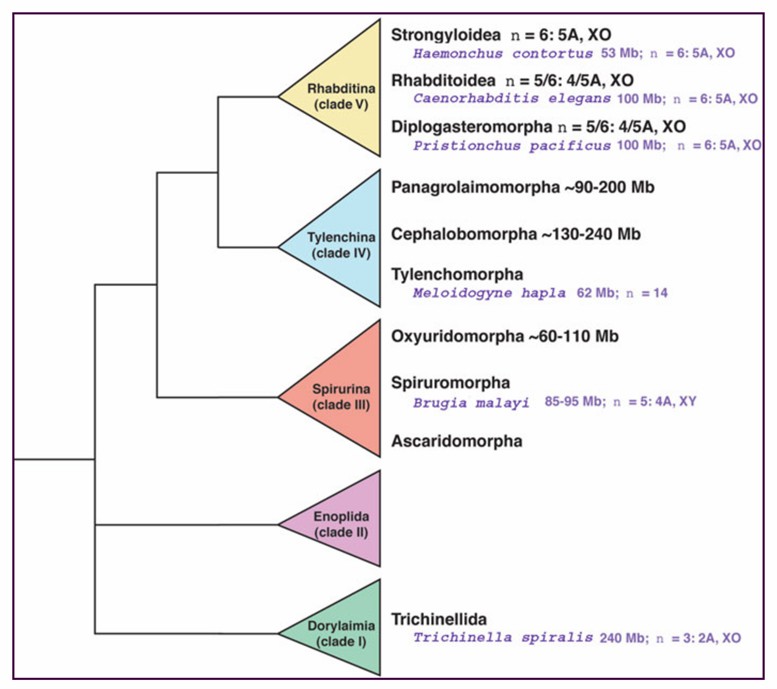Genetic Analysis of Plant Nematodes
Plant nematode is one of the main pathogens of crops, which has a wide host range and is difficult to control, resulting in significant crop yield and serious economic losses yearly. Genetic studies of plant parasitic nematodes, including the analysis of plant nematode genome, mitochondrial genome, calreticulin, and effector proteins, play an irreplaceable role in revealing the molecular mechanism of the interaction between plant nematodes and their hosts, thus helping to select and breed nematode resistant varieties.
Lifeasible, as a leading global company, is committed to helping our customers achieve effective and successful research. We provide the detection of plant nematodes based on morphology, molecular biology, and protein analysis. In addition, we deliver reliable results and reports on time to our customers worldwide.
- The genome of Caenorhabditis elegans was the first nematode genome to be sequenced and the first animal genome to be reported. With the application of high-throughput sequencing technology to plant nematodes, more and more plant nematode genomes have been reported.
- Lifeasible provides genomic analysis of plant nematodes, including the basic characteristics of plant nematode genome, genome variation, gene expression regulation, horizontal gene transfer, gene family expansion, etc.
 Fig.1 Genome size and chromosome number variation across the phylum nematode. (Coghlan A., 2005)
Fig.1 Genome size and chromosome number variation across the phylum nematode. (Coghlan A., 2005)
- Nematode is a kind of multicellular eukaryote, and mitochondria are the organelle of oxidation function of most eukaryotic cells. It has a set of genetic genomes independent of the nucleus, namely the mitochondrial genome.
- We provide mitochondrial genome analysis of plant nematodes, which can be used in nematode population identification, population genetics, and phylogenetic analysis. Besides, we mainly help our clients with mitochondrial genome sequencing, data analysis, and applications.
- Recent transcriptome and genome projects have dramatically expanded the biological data available across the plant nematodes.
- We provide comparative analysis of plant nematode genomes, including genome sequences and mitochondrial genome sequences.
- Calreticulin is a multifunctional protein located in the endoplasmic reticulum of eukaryotic cells and widely exists in higher organisms. It has three functional domains: N-functional, P-functional, and C-functional.
- We provide the analysis of calreticulin in plant nematodes, such as synthesis, secretion, and functions analyses, to provide a theoretical basis for the prevention and control of plant nematode diseases.
- When plant nematodes infect their hosts, they pierce the plant cell wall through oral needles and send endocrine substances to change the structure and function of host cells. These secretions are usually called effector proteins.
- We provide the analysis of plant effector proteins, including the mechanism of their degradation of the host cell wall and the regulatory mechanism of their induction of immune response.
- Genetic variation originates from mutation and recombination and is removed by selection and drift. Many hermaphroditic nematode species reproduce by self-fertilization with occasional outcrossing events via males rather than obligatory outcrossing such as in most animals.
- We provide the analysis of the genetic diversity of plant nematodes, from nucleic acid extraction to ITS sequence analysis, high-throughput sequencing analysis, and more.
Lifeasible is always devoted to providing high-quality and satisfactory service to our customers. If you are interested in our services or have any questions, please feel free to contact us or make an online inquiry.
Reference
- Coghlan A. (2005). "Nematode genome evolution." WormBook.
For research or industrial raw materials, not for personal medical use!
 Fig.1 Genome size and chromosome number variation across the phylum nematode. (Coghlan A., 2005)
Fig.1 Genome size and chromosome number variation across the phylum nematode. (Coghlan A., 2005)